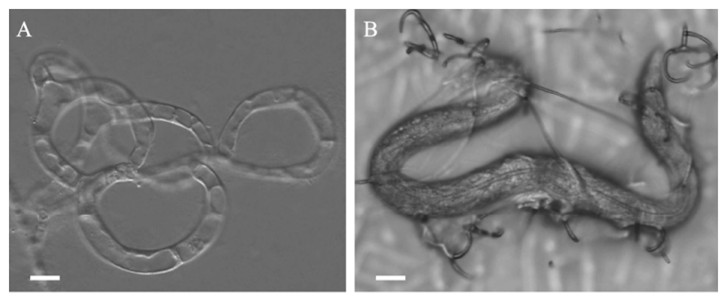Control of Plant Nematodes by Predatory Fungi
Predatory fungi are a group of fungi that produce a variety of traps, including sticky nets, sticky balls, sticky branches, constriction rings, and three-dimensional fungal nets, to catch nematodes. To date, more than 380 species of predatory fungi have been reported from around the world, including members of the phyla Splanchomycetes, Ascomycetes, Stromatophora, and Hemiptera. They are widely distributed worldwide and exist in various ecological environments, including agricultural soils, garden soils, forest soils, etc.
Lifeasible is a credible provider of high-quality functional analysis services for predation plant nematodes by fungi. Our platform has state-of-the-art facilities and highly experienced staff to support projects in all areas. We guarantee to deliver results on time to our customers.
Analysis of the Formation of Fungal Predatory Organ
- The predatory organ is essential for the capture and infestation of nematodes by nematode-feeding fungi, including sticky nets, sticky balls, sticky branches, constriction rings, and three-dimensional fungal nets, which is an indicator of the shift from saprophytic to predatory modes of nematode-feeding fungi organ.
- In addition to metabolites secreted by plant parasitic nematodes that induce predatory fungi to produce predatory organs, metabolites produced by abscisic acid, soil inter-rhizosphere bacteria, and non-parasitic nematodes all play an essential role in inducing trap formation.
 Fig.1 Morphology of the predatory organ.
Fig.1 Morphology of the predatory organ.
- Lifeasible provides an analysis of the effects of metabolites secreted by non-parasitic nematodes on fungal predatory organs, including paganins A / B, blumenol A, and others, which affect the rate of formation of sticky webs and conidiophores at different concentrations. In addition, we offer an analysis of the effects of metabolites secreted by nematodes on the formation of predatory organs.
- We also offer analysis services for soil-based rhizobacteria in forming induced fungal predatory organs, such as Chryseobacterium sp. and its metabolites, which attaches to the mycelium of the predatory fungus is necessary for the formation of the trap. Further, we help our customers discover the substances that induce predatory nematode fungi to produce predatory organs.
Analysis of the Sticky Material Produced by Predatory Organs
In addition to the inducing substances, the sticky substances produced by the predatory organs are also important for efficient nematode predation. There are few reports on the specific composition of the sticky substances. We help our clients analyze the sticky material produced by predatory organs to provide easy access for their research.
Lifeasible provides fast turnaround, high-quality services at competitive prices for customers worldwide. Our advanced technical platforms can help our clients complete the research process with quality and quantity. If you are interested in our services or have any questions, please feel free to contact us or make an online inquiry.
For research or industrial raw materials, not for personal medical use!
 Fig.1 Morphology of the predatory organ.
Fig.1 Morphology of the predatory organ.